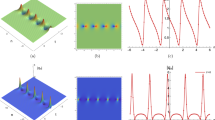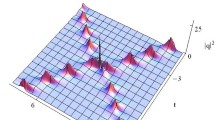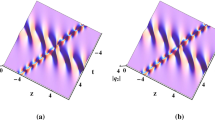Abstract
The inhomogeneous fourth-order nonlinear Schrödinger equation is investigated, which models the transport of energy along the inhomogeneous hydrogen bonding spines in alpha-helical proteins. The deformed breather and rogue waves solutions for the equation are derived via Darboux transformation. Thereinto, the modified limit procedure in generalized Darboux transformation is proposed to construct the expressions of higher-order rogue waves. Due to the presence of inhomogeneity, despite their diversity profiles, the shape, amplitude and pulse width of each deformed breather will change with time. When the coefficients of higher-order terms are varied, the propagating trajectories of breathers are changed. Head-on collision, partially coalesced, without interaction between two deformed breathers is found under diverse selected parameters. The temporal-spatial structures of the presented rogue waves exhibit certain valleys around one or several centers, and the peak heights of those rogue waves are more than three times that of the background. Additionally, the distributed area of the rogue wave will tend to be broaden/narrow along the temporal axis, with the variation of the coefficients of inhomogeneity and higher-order terms.







Similar content being viewed by others
References
Cruzeiro, L.: The Davydov/Scott model for energy storage and transport in proteins. J. Biol. Phys. 35, 43–55 (2009)
Veni, S.S., Latha, M.M.: Effect of inhomogeneity in energy transfer through alpha helical proteins with interspine coupling. Commun. Nonlinear Sci. Numer. Simul. 19(8), 2758–2770 (2014)
Georgiev, D.D., Glazebrook, J.F.: On the quantum dynamics of Davydov solitons in protein \(\alpha \)-helices. Phys. A 517, 257–269 (2019)
Pang, X.F.: The theory of bio-energy transport in the protein molecules and its properties. Phys. Life Rev. 8, 264–286 (2011)
Jeba, K.A., Latha, M.M., Jain, S.R.: Phase space trajectories and Lyapunov exponents in the dynamics of an alpha-helical protein lattice with intra-and inter-spine interactions. Chaos 25, 113109 (2015)
Aboringong, E.N.N., Dikandé, A.M.: Exciton dynamics in amide-I \(\alpha \)-helix protein chains with long-range intermolecular interactions. Eur. Phys. J. E 41(3), 35 (2018)
Piazza, F., Sanejouand, Y.H.: Discrete breathers in protein structures. Phys. Biol. 5, 026001 (2008)
Peyrard, M., Farago, J.: Nonlinear localization in thermalized lattices: application to DNA. Phys. A 288, 199–217 (2000)
Latha, M.M., Veni, S.S.: Multisoliton interaction in discrete alpha-helical proteins with interspine coupling. Phys. Script. 83, 035001 (2011)
Kong, L.Q., Liu, J., Jin, D.Q., Ding, D.J., Dai, C.Q.: Soliton dynamics in the three-spine \(\alpha \)-helical protein with inhomogeneous effect. Nonlinear Dyn. 87(1), 83–92 (2017)
Smetlin, S., Latha, M.M., Vasanthi, C.C.: Localized excitations and influence of exciton-exciton, exciton-phonon interactions in a 3D vector model of alpha-helical protein system. Eur. Phys. J. D 70(10), 209 (2016)
Merlin, G., Latha, M.M.: Two exciton energy transfer in an inhomogeneous alpha-helical protein chain. Phys. D 265, 71–77 (2013)
Mvogo, A., Ben-Bolie, G.H., Kofané, T.C.: Solitary waves in an inhomogeneous chain of \(\alpha \)-helical proteins. Int. J. Mod. Phys. B 28(17), 1450109 (2014)
Okaly, J.B., Mvogo, A., Woulaché, R.L., Kofané, T.C.: Nonlinear dynamics of long-range diatomic chain. Phys. A 541, 123613 (2020)
Daniel, M., Latha, M.M.: A generalized Davydov soliton model for energy transfer in alpha helical proteins. Phys. A 298, 351–370 (2001)
Kavitha, L., Daniel, M.: Integrability and soliton in a classical one-dimensional site-dependent biquadratic Heisenberg spin chain and the effect of nonlinear inhomogeneity. J. Phys. A 36, 10471 (2003)
Wang, P., Tian, B., Jiang, Y., Wang, Y.F.: Integrability and soliton solutions for an inhomogeneous generalized fourth-order nonlinear Schrödinger equation describing the inhomogeneous alpha helical proteins and Heisenberg ferromagnetic spin chains. Phys. B 411, 166–172 (2013)
Herrera, J., Maza, M.A., Minzoni, A.A., Smyth, N.F., Worthy, A.L.: Davydov soliton evolution in temperature gradients driven by hyperbolic waves. Phys. D 191, 156–177 (2004)
Simo, E.: Jacobian elliptic solitons in inhomogeneous alpha-helical proteins. Phys. Script. 80, 045801 (2009)
Gu, C.H., Hu, H.S., Zhou, Z.X.: Darboux Transformation in Integrable Systems: Theory and Their Applications to Geometry. Springer, Dordrecht (2005)
Su, C.Q., Gao, Y.T., Xue, L., Wang, Q.M.: Nonautonomous solitons, breathers and rogue waves for the Gross-Pitaevskii equation in the Bose–Einstein condensate. Commun. Nonlinear Sci. Numer. Simul. 36, 457–467 (2016)
Yong, X.L., Wang, G., Li, W., Huang, Y.H., Gao, J.W.: On the Darboux transformation of a generalized inhomogeneous higher-order nonlinear Schrödinger equation. Nonlinear Dyn. 87, 75–82 (2017)
Xu, T., Chen, Y.: Darboux transformation of the coupled nonisospectral Gross–Pitaevskii system and its multi-component generalization. Commun. Nonlinear Sci. Numer. Simul. 57, 276–289 (2018)
Yong, X.L., Fan, Y.J., Huang, Y.H., Ma, W.X., Tian, J.: Darboux transformation and solitons for an integrable nonautonomous nonlinear integro-differential Schrödinger equation. Mod. Phys. Lett. B 31(30), 1750276 (2017)
Yao, Y.Q., Huang, Y.H.: High-order rogue-wave of the inhomogeneous nonlinear Hirota equation with a self-consistent source. Mod. Phys. Lett. B 33(08), 1950087 (2019)
Islas, A., Schober, C.M.: Numerical investigation of the stability of the rational solutions of the nonlinear Schrödinger equation. Appl. Math. Comput. 305, 17–26 (2017)
Mao, J.J., Tian, S.F., Zou, L., Zhang, T.T., Yan, X.J.: Bilinear formalism, lump solution, lumpoff and instanton/rogue wave solution of a (3+1)-dimensional B-type Kadomtsev-Petviashvili equation. Nonlinear Dyn. 95(4), 3005–3017 (2019)
Liu, Y., Qian, C., Mihalache, D., He, J.S.: Rogue waves and hybrid solutions of the Davey–Stewartson I equation. Nonlinear Dyn. 95(1), 839–857 (2019)
Van Gorder, R.A.: Optimal homotopy analysis and control of error for implicitly defined fully nonlinear differential equations. Numer. Algorithm 81, 181–196 (2019)
Xie, X.Y., Yang, S.K., Ai, C.H., Kong, L.C.: Integrable turbulence for a coupled nonlinear Schrödinger system. Phys. Lett. A 384, 126119 (2020)
Guo, B.L., Ling, L.M., Liu, Q.P.: Nonlinear Schrödinger equation: generalized Darboux transformation and rogue wave solutions. Phys. Rev. E 85, 026607 (2012)
Meng, G.Q., Pan, Y.S., Tan, H.F., Xie, X.Y.: Analytic solutions for the (2+1)-dimensional generalized sine-Gordon equations in nonlinear optics. Comput. Math. Appl. 76, 1535–1543 (2018)
Xie, X.Y., Meng, G.Q.: Dark solitons for a variable-coefficient AB system in the geophysical fluids or nonlinear optics. Eur. Phys. J. Plus 134, 359 (2019)
Zuo, D.W., Zhang, G.F.: Exact solutions of the nonlocal Hirota equations. Appl. Math. Lett. 93, 66–71 (2019)
Meng, X.H., Wen, X.Y., Piao, L., Wang, D.S.: Determinant solutions and asymptotic state analysis for an integrable model of transient stimulated Raman scattering. Optik 200, 163348 (2020)
Huang, Y.Z., Yu, X.: Solitons and peakons of a nonautonomous Camassa–Holm equation. Appl. Math. Lett. 98, 385–391 (2019)
Du, Z., Tian, B., Qu, Q.X., Chai, H.P., Zhao, X.H.: Vector breathers for the coupled fourth-order nonlinear Schrödinger system in a birefringent optical fiber. Chaos Soliton Fract. 130, 109403 (2020)
Fan, E.G., Chow, K.W.: Darboux covariant Lax pairs and infinite conservation laws of the (2+1)-dimensional breaking soliton equation. J. Math. Phys. 52, 023504 (2011)
Pei, L.M., Li, B., Xu, S.W.: The integrability conditions and solutions of nonautonomous Hirota equation. Nonlinear Dyn. 90(3), 2111–2118 (2017)
Brugarino, T., Sciacca, M.: Integrability of an inhomogeneous nonlinear Schrödinger equation in Bose–Einstein condensates and fiber optics. J. Math. Phys. 51, 093503 (2010)
Xie, X.Y., Liu, X.B.: Elastic and inelastic collisions of the semirational solutions for the coupled Hirota equations in a birefringent fiber. Appl. Math. Lett. 105, 106291 (2020)
Ma, Y.L.: Interaction and energy transition between the breather and rogue wave for a generalized nonlinear Schrödinger system with two higher-order dispersion operators in optical fibers. Nonlinear Dyn. 97(1), 95–105 (2019)
Peng, W.Q., Tian, S.F., Zhang, T.T.: Breather waves, high-order rogue waves and their dynamics in the coupled nonlinear Schrödinger equations with alternate signs of nonlinearities. Europhys. Lett. 127(5), 50005 (2019)
Lan, Z.Z.: Rogue wave solutions for a coupled nonlinear Schrödinger equation in the birefringent optical fiber. Appl. Math. Lett. 98, 128–134 (2019)
Dudley, J.M., Genty, G., Mussot, A., Chabchoub, A., Dias, F.: Rogue waves and analogies in optics and oceanography. Nat. Rev. Phys. 1, 675–689 (2019)
Dematteis, G., Grafke, T., Onorato, M., Vanden-Eijnden, E.: Experimental evidence of hydrodynamic instantons: the universal route to rogue waves. Phys. Rev. X 9, 041057 (2019)
Ducrozet, G., Bonnefoy, F., Mori, N., Fink, M., Chabchoub, A.: Experimental reconstruction of extreme sea waves by time reversal principle. J. Fluid Mech. 884, A20 (2020)
Efimov, V.B., Ganshin, A.N., Kolmakov, G.V., McClintock, P.V.E., Mezhov-Deglin, L.P.: Rogue waves in superfluid helium. Eur. Phys. J.-Spec. Top. 185, 181–193 (2010)
Li, S., Prinari, B., Biondini, G.: Solitons and rogue waves in spinor Bose–Einstein condensates. Phys. Rev. E 97, 022221 (2018)
Shahein, R.A., El-Shehri, J.H.: Bifurcation analysis of dissipative rogue wave in electron-positron-ion plasma with relativistic ions and superthermal electrons. Chaos Soliton Fract. 128, 114–122 (2019)
Acknowledgements
The authors express sincere thanks to all the members of our discussion group. Our work has been supported by the Fundamental Research Funds for the Central Universities (Nos. 2017MS164 & 2017BD0094, NCEPU) and the National Natural Science Foundation of China under Grant No. 11905061.
Author information
Authors and Affiliations
Corresponding author
Ethics declarations
Conflict of interest
The authors declare that there is no conflict of interests regarding the publication of this article.
Additional information
Publisher's Note
Springer Nature remains neutral with regard to jurisdictional claims in published maps and institutional affiliations.
Appendices
Appendix A
The expressions for \(d_1(t)\) and \(d_2(t)\) in Eq. (12) are given as
where \(m_1=256 \rho _1^2 h_1^4+4 \sigma _1^2 \sigma _2^2 h_1^2-4 \xi \sigma _1^2 \sigma _2 h_1+\xi ^2 \sigma _1^2\), \(m_2=-2 \sigma _1^2 \sigma _2 \left( t+\sigma _2\right) h_1+\xi \sigma _1^2 \left( t+\sigma _2\right) -128 \,\rho _1^2\, h_1^3\), \(m_3=512 \rho _1^2 h_1^4 -4 t \sigma _1^2 \sigma _2 h_1^2+2 \xi \sigma _1^2 \left( t-\sigma _2\right) h_1+\xi ^2 \sigma _1^2\), and \(\sigma _3\) and \(\sigma _4\) are constants.
Appendix B
The definition of the coefficients in Eq. (24) are expressed as
with \(n_3=(t+1)^2+\frac{256}{25}\).
Rights and permissions
About this article
Cite this article
Meng, GQ., Pan, YS. & Xie, XY. Deformed breather and rogue waves for the inhomogeneous fourth-order nonlinear Schrödinger equation in alpha-helical proteins. Nonlinear Dyn 100, 2779–2795 (2020). https://doi.org/10.1007/s11071-020-05622-6
Received:
Accepted:
Published:
Issue Date:
DOI: https://doi.org/10.1007/s11071-020-05622-6




